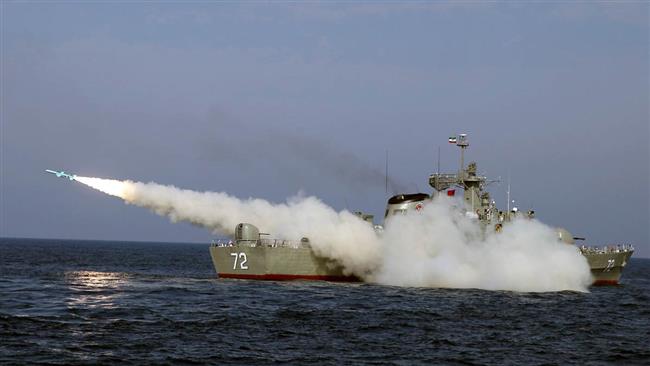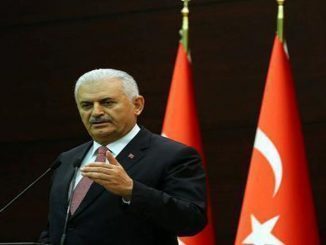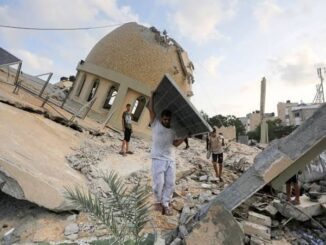
A navy confrontation between U.S. and Iranian vessels in the strait of Hormuz sparked more tension as both sides blamed one another for the incident.
Trump has said during his election campaign that Iran’s nuclear deal as “disastrous” and said it would be his “number one priority” to dismantle it.
These threats became clearer after Trump’s inauguration, as he signed an executive order temporarily barring thousands from seven countries in the Middle East and Africa, including Iran, from obtaining visas to travel to the United States.
The tension was raised again in issues related to Iran’s ballistic program, as he said that “Iran is playing with fire” and announced that “we’re officially putting Iran on notice,” after Iran conducted a failed ballistic missile test.
In addition, Trump declared in January applying sanctions on 25 individuals and companies connected to Iran’s ballistic missile program and those providing support to Iran’s Islamic Revolutionary Guard Corps’ Quds Force.
Recently, US senators said plan to impose new sanctions on Iran over its ballistic missile program, while Israel and Saudi Arabia backed these measures and described Iran as the main sponsor of global “terrorism” and a destabilizing force in the Middle East.
All of these incidents raised the tension between the two countries to high levels, while both of them traded threatening declarations and conducted naval drills as shows of power.
Exchanging blames
A U.S. official told Reuters on Monday that multiple fast-attack vessels from the Revolutionary Guard had come within 600 yards (550 meters) of the USNS Invincible, a tracking ship, forcing it to change direction.
The last serious naval incident was in January when a U.S. destroyer fired three warning shots at four Iranian fast-attack vessels near the Strait after they closed in at high speed and disregarded repeated requests to slow down.
In the incidents involving the Invincible, an Iranian frigate came within 150 yards of the Navy ship on Thursday, a Pentagon spokesman, Capt. Jeff Davis, told reporters. On Saturday, a number of smaller boats approached the U.S. ship, closing to within 600 yards, Davis said.
Surveillance ships like the Invincible are typically equipped with scientific instruments and radar that allow them to monitor missiles and rockets from their launching to the point that they land.
A Navy official condemned the Iranian actions as “unsafe and unprofessional.”
British and U.S. warships patrol the regional waters, and three ships from Britain’s Royal Navy were reportedly accompanying the Invincible. State Department officials said they were aware of reports that Iran had tested an air defense system but could provide no further information.
“These provocative tests are just the latest example of Iran’s dangerous actions that demand a coordinated, multifaceted response from the United States,” said Senate Foreign Relations Committee Chairman Bob Corker (R-Tenn.). “The administration has already begun to push back in the way that we should, and I look forward to working with them as we prepare to introduce bipartisan legislation to deter Iran’s threatening behavior on all fronts.”
Iranian threats
However, Revolutionary Guard commander Mehdi Hashemi said the incident was the fault of the U.S. ship, telling the Fars news agency: “The unprofessional actions of the Americans can have irreversible consequences,”
“Such provocations can have irreversible consequences,” Admiral Mehdi Hashemi said.
“A U.S. warship from the American and British fleet that was passing the traffic zone of the Strait of Hormuz, changed direction from the international route toward the boats of the IRGC navy.”
While warning, the U.S. warship had acted “unprofessionally” and had come within 550 meters of the boats, Hashemi added, accusing Washington of resorting to “lying” and “propaganda techniques.”
Iranian president Hassan Rouhani, without referring to the Hormuz incident, also gave a warning on Wednesday.
“If Iran’s ignorant enemies think about invading Iran they should know that our armed forces are much stronger than 1980 when Iraq attacked,” he said in a speech broadcast live on state TV.
Western navies held in February a series of drills off the coast of Iran last week, in a show of force in light of increased Iranian harassment of foreign military vessels.
The exercises, dubbed “United Trident,” were led by the United Kingdom and included ships from the US, France and Australia. The navies practiced fighting off enemy aerial incursions and mine clearing, as well as live fire drills.
The final drill featured 13 ships from the allied navies sailing in formation, with helicopters flying overhead.
Last month, Iranian Navy Commander Rear Admiral Habibollah Sayyari was dismissive of the show of force close to Iranian waters, warning the Western navies against encroaching on Iranian waters, saying, “This is our red line.”
New missile systems
This incident came as Iran tested its newly deployed S-300 missile system in wide-range military drills.
The Iranian drill on Saturday, dubbed “Damavand,” saw the Iranian armed forces test the Russian-made system against a variety of aerial targets, including a ballistic missile which, according to Brigadier-General Farzad Esmaili, the commander of Iran’s Khatam al-Anbiya Air Defense Base, was “smashed” by the S-300.
Iranian State TV aired footage of the missiles launching, saying that the drill took place in Iran’s central desert region, without giving a precise location.
According to Iran’s IRIB news agency, the country is now in the midst of developing its own version of the S-300 system, quoting Brig.-Gen. Esmaili, as saying the Bavar-373 system, which “would be [more] technologically advanced than the S-300” was due to be tested “in the near future.”
Tehran and Moscow signed a contract for the S-300 in 2007, but it was suspended in 2010 after the UN Security Council passed a resolution banning the sale of advanced weapons to the Tehran.
The restriction was lifted last year after Iran and six leading world powers signed a deal addressing concerns over Iran’s nuclear program. The development allowed Russia and Iran to renegotiate the terms of the almost decade-old contract, resolving a dispute over its suspension.



